What weapons are being used in the Israel-Gaza conflict
- Published
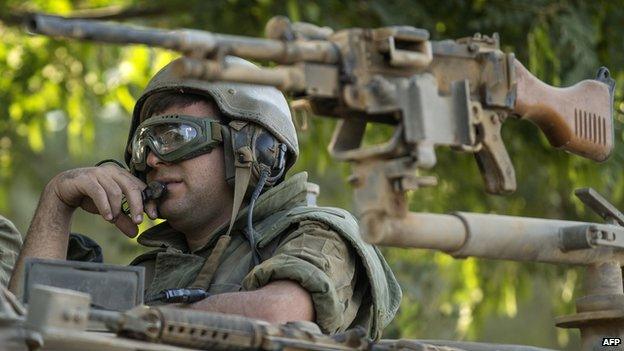
The struggle between the Israeli military and the armed wings of Hamas and other Palestinian groups in the Gaza Strip is a classic asymmetrical conflict. The two sides are far from evenly matched but each can nonetheless bring considerable pressure to bear upon the other.
Inevitably, though, the burden of casualties is asymmetric too. The death toll among Palestinians is rising markedly as the Israeli air campaign intensifies. The Gaza Strip is a relatively small area. Much of it is densely populated.
Israel claims that a significant proportion of the Hamas infrastructure is located in civilian areas.
The Israel Defense Forces (IDF) say they take great care in targeting to try to reduce civilian casualties to a minimum, but there are controversial aspects to their targeting policy: for example, the decision to strike at the homes of known Palestinian military commanders, condemned not least by Israeli human rights groups.
Israel's extraordinary practice of calling up the residents of such homes to warn them to vacate the premises ahead of any attack does not alter the fact that deaths have occurred.
So what resources are the two sides using in this conflict and are they locked into a cycle of escalation that makes a new ground war more likely?
Palestinian rocket arsenal
Hamas and other, more radical Palestinian groups in the Gaza Strip have built up an arsenal of basic rockets which over the years have steadily increased in range. This is an important factor. None of them are particularly sophisticated.
Most are based upon Soviet-era technology and are artillery rockets that were designed to be fired in large barrages rather than individually.
Some were imported through the smuggling tunnels from the Sinai; some are constructed in workshops in the Gaza Strip, though many of these may still depend for key parts on components from Iran or Syria smuggled in through the self-same tunnels or by other methods.

Remains of a Hamas-fired rocket on Israel's southern border with Gaza
Shorter-range systems include heavy mortars and Grad and Qassam rockets with ranges of up to 48km (30 miles) and 17km respectively. They threaten towns and cities in southern Israel, like Sderot, Ashkelon and even Beersheba and the port of Ashdod.
There is also the longer range Fajr-5, sometimes also designated the M75. It can reach up to 75km, threatening major population centres like Tel Aviv and Jerusalem.
But using the Fajr-5 brings huge practical problems. It is heavy and fairly large - some 6m (20ft) tall. It requires mechanical handling and needs to be pre-positioned in hidden launch sites and camouflaged from the prying eyes of Israeli drones.
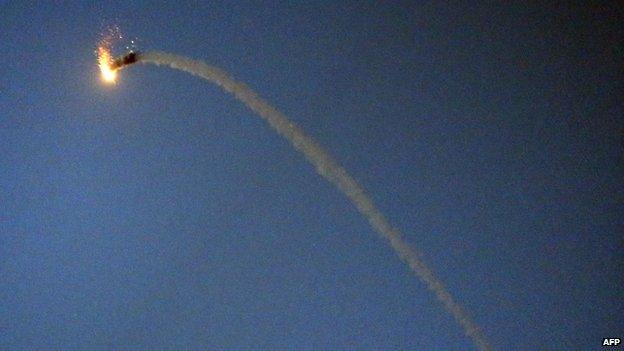
A Hamas-made M75 after it was launched from Gaza towards Israel
A novelty in this latest conflict is the apparent use by the Palestinians of an even longer-range system - thought to be a Syrian built-missile - the Khaibar-1.
This was first used earlier this month and has a range of up to 160km which brings Israel's northern coastal city of Haifa within reach. A weapon that crops up in some of the reporting has the designation M-302 which has a similar range.
Range here is crucial. Bringing the population of major Israeli cities under threat, however inaccurate the weapon, causes huge disruption and fear.
It brings significant pressure on the Israeli government - pressure that works both ways, on the one hand to push it into escalating the conflict, but equally reminding it of the potential cost of any drawn-out conflict.
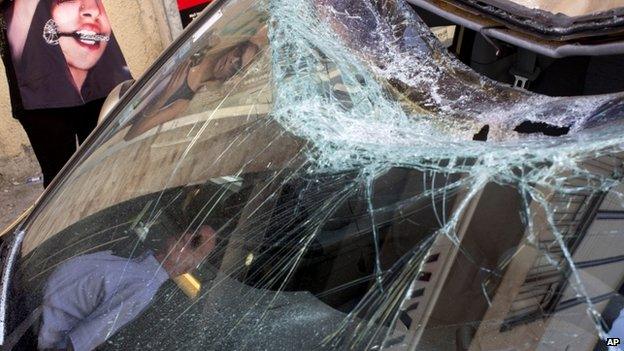
Damage caused by long-range rocket shot down by Israel's Iron Dome in Tel Aviv
The problem for Hamas and other armed groups is their limited ability to sustain such operations. Israeli intelligence sources suggest that Palestinian groups have several thousand shorter-range rockets but that they have only stockpiled perhaps a few hundred longer-range systems at most.
Palestinian leaders are also mindful of the fact that the new Egyptian government has taken steps to close down many of the tunnels between Gaza and the Sinai, making the future re-supply of missiles and components more difficult.

•Infiltration on the Ground.
Palestinian fighters are not entirely passive. They clearly have well-developed defence plans to try to thwart any Israeli incursion on the ground. There is an elaborate underground infrastructure and Israeli operational practices from previous rounds of fighting will have been carefully studied.
In a limited way the Palestinians have sought to mount their own ground operations, for example evading the Israeli Navy and landing a small team of infiltrators on the Israeli coast. These were quickly spotted and intercepted.
Israeli air power and the Iron Dome
Israel's response to the upsurge in rocket fire has been both defensive and offensive in nature.
The full panoply of Israeli air power has been used in a steadily escalating series of attacks against rocket launch sites, weapons stores, and the command elements of Hamas and other groups.
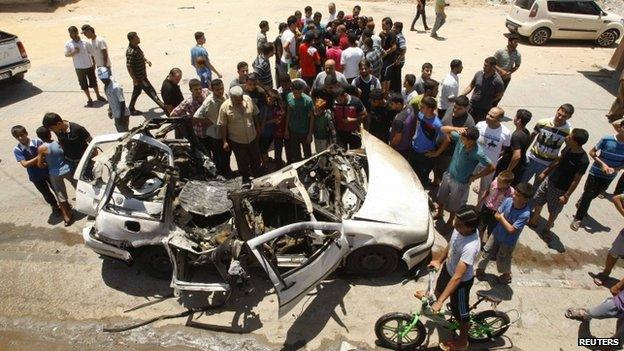
Many civilians have been caught up in the Israeli air strikes on Gaza
So far this has not halted the rocket fire but it has brought an increasing toll of Palestinian casualties. The attacks have not yet been anything like as intensive as the early stages of the last upsurge in fighting, in November 2012.
As important in determining Israel's strategic outlook as its offensive operations is the reliance that it places on missile defence - the Iron Dome system - to defend its civilian population. Indeed, as long as it is successful it is a powerful factor in crisis limitation.
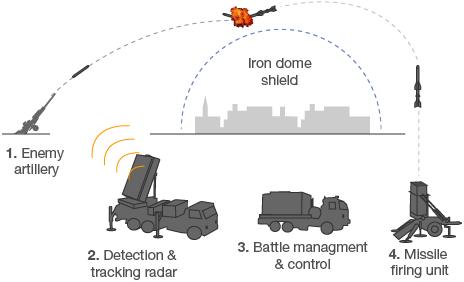
Significant Israeli casualties from a Palestinian rocket strike on a city would almost inevitably provoke a ground operation.
Iron Dome cannot intercept every missile. Batteries are made up of interceptor missiles: radars and command systems that analyse where target missiles might fall and only intercept those deemed to be heading for civilian areas.
As of Thursday morning, for example the IDF said that 255 rockets had hit Israel since the start of the operation. Only 71 were intercepted by the Iron Dome.
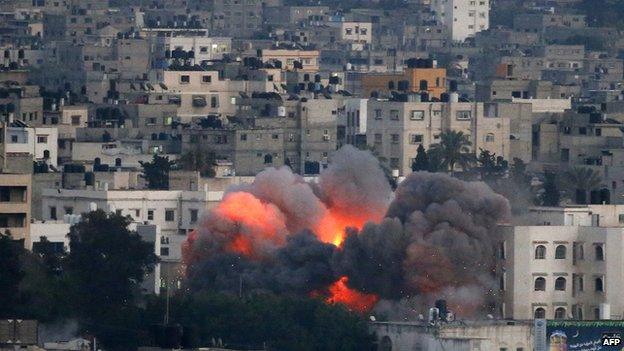
Israel has carried out targeted air strikes on what it says are the homes of Hamas commanders in Gaza
Israel rigorously guards detailed data on Iron Dome's performance. Its earlier use has prompted some debate among experts on its seemingly extraordinary success rate. But whatever the basic data, the evidence from its use suggests that it is having a significant effect in preventing Israeli casualties.
Israel is also building up its forces for a ground operation if necessary. Some three brigades have already been deployed near the border with the Gaza Strip and reservists are being mobilised.
Where to from here ?
If the rocket fire continues, so, too, will the Israeli air strikes, and the Palestinian death toll will rise.
There will be growing criticism of Israel from outside - the country is already launching something of a diplomatic offensive to get its point of view across - but again, if the rocket fire does not stop, many of its friends and allies realise the pressures that Prime Minister Netanyahu's government is under.
But Hamas is under huge pressure too. Its poor relations with Egypt; its financial problems; and the dismantling of much of its infrastructure in the West Bank, mean that it is peculiarly isolated. Its military commanders seem to believe that there is something to be gained from a new demonstration of "resistance" against Israel.
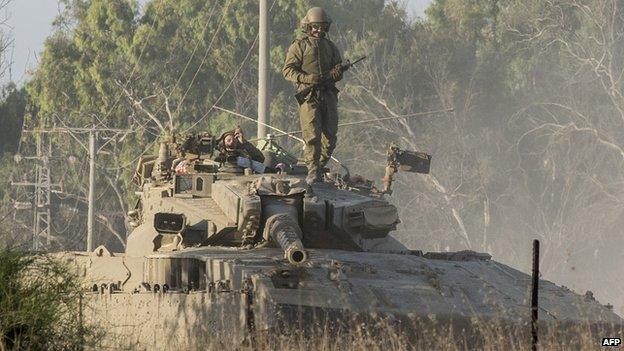
Israel says it is prepared to launch a ground offensive in Gaza if necessary
Paradoxically the weakness of Hamas is a problem for Israel too. It cannot sweep Hamas away, however much some on the Israeli right would like to see this.
The alternative to Hamas rule might be anarchy with extremist jihadist groups seizing control and other fighters flowing in from the Sinai.
That would be of no benefit to Israel's future security. Nonetheless, each day the rocket fire continues so the likelihood of a ground incursion grows.
Israel insists it has not sought such an operation. Hamas's most significant "achievement" might be to draw it into just such a move.